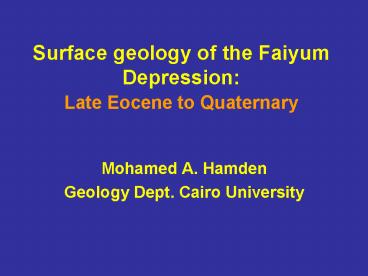Surface geology of the Faiyum Depression: Late Eocene to Quaternary PowerPoint PPT Presentation
1 / 22
Title: Surface geology of the Faiyum Depression: Late Eocene to Quaternary
1
Surface geology of the Faiyum DepressionLate
Eocene to Quaternary
- Mohamed A. Hamden
- Geology Dept. Cairo University
2
Location
The Faiyum Depression is a circular basin in to
Western Desert of Egypt, situated directly west
of the Nile Valley and 80 km south of Cairo.
3
Stratigraphy Of Northern Faiyum Depression
4
(No Transcript)
5
(No Transcript)
6
Northern Faiyum
Qaret el Gindi
Qasr Sagha
7
(No Transcript)
8
Basalt Quarry
Wedan el Faras
The oldest paved road
Ancient basalt working
9
East Faiyum Fag el Gamous
10
Gerza
Gerza
11
Wadi Nazla
12
Lahun
Kom el Hamam
Kom Teifah
13
Qaret El Rusas
14
Carving of Faiyum Depression since the Oligocene
up to Early Pleistocene (After Issawi et al.,
2001)
15
Pleistocene
16
Holocene
Paleomoeris Lake Premoeris Lake Protomoeris
Lake Moeris Lake
17
Palaemoeris
The deposits of Palemoeris were seen only in one
locality and are represented by fluvial sand and
diatomite (9000 B.P.) at an elevation of about
12m asl.
In the Western Faiyum, It recorded at about 11-12
m a. s. l. (1) Bedrock, limestone (2) Very
fine grained sand with shells pale gray (2.5 Y
7/2), 30 cm thick. (3) Very fine sand, shelly,
with angular rubble , very pale brown (10YR8/3),
40 cm (4) A weak gypsiferous reddish yellow
paleosol (7.5YR6/6), 20cm thick
18
Protomoeris
It represented by sand with intercalation of
dark grayish brown loose powdery sediments
overlying the desiccated surface of the
Paleomoeris diatomaceous deposits. A date of 8100
130 B.P. on charcoal was obtained at an
elevation of 15 to 19 m a.s.l. contemporaneous
with a mat of swampy deposits
19
Protomoeris
The deposits of this lake are represented by sand
and sandy silt intercalated with dark swamp
layers. These deposits are similar to those of
the Premoeris lake, but a disconformity separates
them ). One date on burnt Pia ovalata shell is
associated with Protomoeris lake deposits. The
date is 7140 120 (Wendorf and Schild,1976).
In the western Fayium, Protomoeris deposits
consist of 10 cm brown (10Yr 5/3) silt with
numerous small lacustrine snails. This grades up
into fine sand with small fresh water snails and
flat rubble. The sand is very pale brown to white
color (10YR 8/4 to 10 YR 8/1). The lower silt
unit is covered with flat and spherical limestone
scree of fresh and reworked patinated gravel.
20
Mid Holocene Lake
Deposits of this lake are recorded in northern
Faiyum), and consist mostly of pale brown sand,
unconformable overlying the older lacustrine
sediments. In western Faiyum, similar deposits
were recorded , about 3 km south west of Quta,
associated with Neolithic artifacts. The
sequence started by about 60 cm very pale brown
hard sand, overlain by about 220 cm cross bedded
coarse grained sand. The section is covered by
about 75 cm pale yellow fine grained sand.
21
Conclusions
1- Qatrani basalt sheet controlled the northern
extension of the depression. 2- Messenian crisis
helped in the excavation of the depreesion to
elevation 50m asl. 3- The excavation ot the
Hawara channel led to the connection of the
depression with and The Nile valley. 4-
Palaeoclimatic variation on the Nile headwater
affected the variation of the lake levels .
22
THANKS
Faiyum Faces

